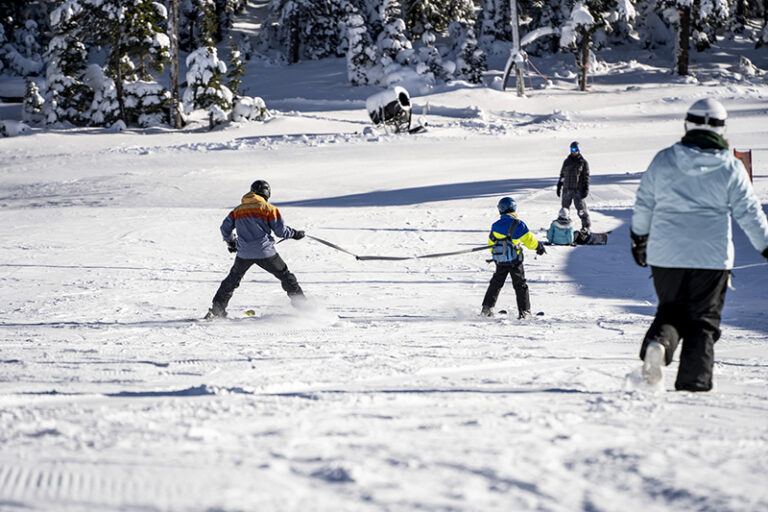Water skiing is like swimming, paddling or fishing – introduce it to your kids when they’re young, and they’ll be your water sport buddies for life. I admit I was skeptical when my husband, a couple years ago, suggested our then-4-year-old son could learn to water ski. Our kid was already a decent alpine skier for his age, but water ski? Then I watched a YouTube video of a 2-year-old water skiing. Challenge accepted.
Children who snow ski and bike ride independently typically have the right mix of physical skills and character traits to learn how to water ski, including good balance, muscle strength, bravery, determination, and enthusiasm for new challenges. With progressive instruction and specialized gear, teaching them to water ski is easier than you may think.
Gear: Trainer water skis have one or more removable stabilizer bars and a wide design to help novice skiers “pop” out of the water. A dual-handle rope is secured to the front stabilizer bar and while the child holds one handle, an adult holds the other while standing in the back of the boat. When the skier falls, the adult simply lets go. A correctly fitted, Coast Guard-certified PFD is required.
Dry Land Training: Familiarize a child with wearing water skis and holding the rope handle while being pulled over a grassy surface. Watch YouTube videos for some DIY help from parents who are experienced water skiers and have successfully taught their own young children to ski, such as Kent Wallace, Seth Stisher, and pro water skier Glenn Campbell.
Shallow Water Training: Simulate a boat tow by running through shallow water with the rope. This allows the child to experience how it feels to ski on top of water, tips up and body leaning back with knees slightly bent.
Deep Water Training: Good weather and pleasant water conditions are essential for creating the best possible first experience. Visit a smaller lake that allows motorized boats or find a small bay in a larger lake to be away from other boat traffic and minimize waves. For pulling a child water skier, the boat speed should be seven to 10 mph. Be sure to read and follow all ski manufacturer instructions and warnings. The collaborative teamwork of four adults is needed: a boat driver, an adult in the water (wearing a PFD) to assist the child with the tucked-knee start position, and two more adults in the boat with one holding the tow rope and the other holding the safety flag.
A small bay allows the adult in the water to watch the action and be protected from other boat traffic. When the ski boat circles back around, and the child is ready for a rest, the tow rope can be released after the boat slows and the child is near the parent in the water. Eventually, the child should be comfortable and skilled enough to start in the water without hands-on assistance.
For children not yet ready for actual water skis, there are inflatable ski trainers. These simulate the water ski experience by allowing a child to either sit or stand, totally out of water, to practice balance and stability while being pulled behind the boat’s wake. It’s essentially tubing with a water ski posture.
While my son got up on water skis after his third attempt, he only stayed upright for about 100 feet before falling over. It was the end of summer and we couldn’t try again until the following July. He was taller and stronger by then, and surprised us by getting up on his first attempt. Thereafter, our family’s boat days were more exciting and adventurous – the best type of summer days. //
Amy Silbernagel McCaffree enjoys sharing stories that inspire people to be more active and adventurous. She contributed several stories to the Summer Adventure June issue.













